First Aid for a First World War Pigeon
by Kayleigh Steele, Museum Assistant - Collections
Looking through Dover Museum’s stores with the “Animals Everywhere” exhibition in mind, I was reminded of a poor taxidermy carrier pigeon with a broken neck in our collection. When we planned the exhibition, we wanted to include as many different themes where animals featured to support the tagline of “Animals really are everywhere” to tie in with the 200-year anniversary of the RSPCA. We felt it was important to have a section on animals in service, and what could have been more fitting than having a carrier pigeon on display. It felt particularly relevant here in Dover with vital messages being flown across the channel. I had been trying to contact conservators for months, to no avail. Four conservators informed us they did not have the time to complete the work. And so, I emailed Simon Moore of Natural History Conservation who informed me he was running a taxidermy conservation course. This would teach the basics of repair and care of specimens, and there were spaces if I wished to attend.
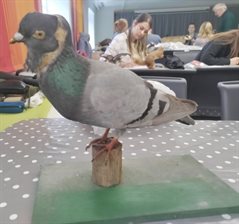
Taxidermy pigeon: before conservation
This was not necessarily a skill I had thought about learning before, but I increasingly thought it would be a good idea. The taxidermy collection at the Museum is one of our founding collections, and it would be good to have more training to look after Fred our iconic polar bear if nothing else! Catherine, our Collections Manager, helped me to apply for a Skills Builder Grant through the Museum Development Southeast grants programme to get the funding to go. This was a carefully outlined application detailing how it would help the museum and how it would help my career growth. This scheme is fantastic in helping small museums get funding they so desperately need for caring for collections.
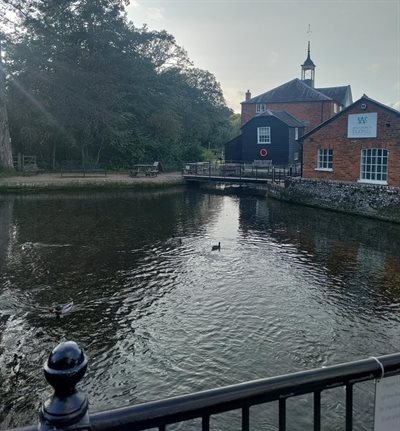
The Whitchurch Historic Silk Mill
The grant was approved, and so I started the three-day course in Whitchurch in Hampshire. The course itself took place in a historic silk mill. The other attendees were all very friendly – a mixture of other museum professionals and private collectors. The course was very interesting, and I learnt many different techniques. We learnt agents of decay, deterioration mechanisms and the importance of tight environmental control to properly care for collections. We were shown common problems natural history collections face, with examples ranging from bottled specimens to dioramas and even a very large taxidermy giraffe! Various methods and materials were discussed, from gampi tissue to glue, treating fat burn and transplanting fur to repairing and replacing eyes, beaks and claws.
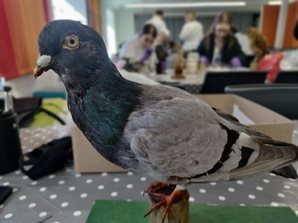
Taxidermy pigeon: after conservation
The conservator running the course, Simon, had also brought along many taxidermy animals that needed repair. These ranged in size and complexity, from a badger right down to a millipede, and all kinds of animals in between. After practicing on a pheasant with a bent tail and many loose feathers, I grew in confidence and tackled Dover Museum’s pigeon. After a thorough clean, rehydrating its legs and feet, it was time to repair the broken neck. This involved gently guiding it back into place, using a conservation adhesive to fix the two seams and reattaching feathers around the neck. The wire aperture was also too long, and poked through the top of the head, but this was carefully snipped and the hole hidden once the neck was properly aligned again. At last, the pigeon was repaired and ready to come back to the museum! Simon agreed we could take home specimens we had worked on, and after spending so many hours on working on the pheasant, I unexpectedly found I had grown fond of it. Needless to say, the journey home was a little strange, with our pigeon safely in its box, and a newly repaired pheasant on the passenger seat!
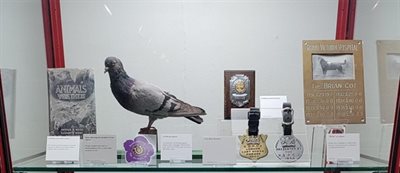
The now repaired taxidermy pigeon now proudly on display in the Animals Everywhere exhibition
The carrier pigeon is now proudly on display in the “Animals Everywhere” exhibition (running until May 2025). You can see other examples of our taxidermy collection in this exhibition as well, including a gharial, a puffer fish and a sloth. Of course, Fred the polar bear and Arthur the lion remain on permanent display in the corridors, and the pheasant, now known as ‘Phil’ has pride of place in my living room (much to the dog’s fascination!).
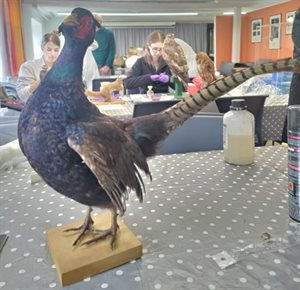
'Phil' the pheasant with re-glued feathers, a straightened tail and glossy, dust free plumage